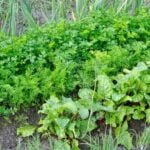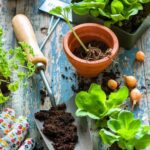Introduction
Blood meal is an incredible soil amendment for vegetable gardens. It is a high nitrogen fertilizer made from dried, ground-up blood. Blood meal offers many benefits for gardening due to its high nitrogen content, which helps promote lush foliage growth and robust yields. It also contains phosphorus and calcium, both of which are important for healthy plant growth. Blood meal can be used in all types of soil, but it works best when incorporated into the top few inches of the soil.
Blood meal’s nitrogen content encourages healthy foliage growth, making plants stronger and more resistant to disease. Additionally, because it is a rich source of organic matter, adding blood meal to your garden will help improve the overall quality of your soil as well as its water retention capacity. By increasing the nutrient-holding capacity of your soil, you create an optimum growing environment for your vegetables or flowers. Moreover, improving the quality and chemistry of your soil with blood meal can increase the amount of beneficial microorganisms in the root zone and decrease diseases caused by fungi or insects by creating less hospitable conditions for their growth. Finally, using blood meal can reduce the need for frequent watering since it helps retain moisture in the soil more effectively than other fertilizers do.
Benefits of Blood Meal for Vegetable Gardening
Blood meal is an excellent natural fertilizer for vegetable gardening. It is an animal by-product, made from the dried and powdered blood of cattle or hogs. The nutrients in blood meal are highly concentrated and include nitrogen, phosphorus, and other minerals that help plants grow strong and healthy. Blood meal can be applied directly to the soil as a slow-release fertilizer. It should be added sparingly because it is more potent than other types of fertilizers.
Blood meal’s high concentration of nitrogen helps produce darker-green leafy vegetables like kale and spinach. Its phosphorus content promotes strong root systems and fruit development in vegetable crops such as tomatoes, peppers, squash, cucumbers, watermelons, beans, and peas. Other minerals found in blood meal such as calcium, magnesium, potassium, iron, zinc and boron provide additional benefits to vegetation health; they help regulate soil pH levels while providing important nutritional elements directly to plant roots.
The presence of micronutrients in blood meal also encourages beneficial microorganisms in the soil to flourish; these organisms benefit plant growth by promoting water retention and nutrient absorption. Additionally, because it provides direct nutrition rather than promoting rapid plant growth with its broad spectrum composition of many macro and micro nutrients alike; using this choice of natural fertilizer will result in slower but healthier growth on average when compared to traditional synthetic chemical fertilizers which may produce faster results but lack some crucial trace elements for optimal vegetable production quality.
Best Ways to Apply Blood Meal to Your Garden
Blood meal is a great way to add additional nitrogen to your vegetable garden. Applying it in the right manner and amount can help you get the most benefits from this fertilizer. Here are some of the best ways to apply blood meal:
1. Use it as a “top-dressing” – Sprinkle small amounts of blood meal around the base of your garden plants, no more than ¼ cup per 10 square feet. This will give your plants an extra boost throughout their growth season.
2. Add it to compost – Composting is a great way to get organic material into your soil, and adding blood meal in with that compost can help increase the nutrient value even further – up to 7-9 percent nitrogen! Use about one cup for every five gallons of composted material.
3. Mix into soil in early spring – Early spring is when plant roots start expanding, so you’ll want to mix some blood meal into the top 4- 6 inches of soil for nitrogen that will be readily available for your plants’ needs. Use one or two cups for every 10 square feet or 1/8 cup per square foot.
4. Feed during side dressing – Side dressing is when food is added around established plants after they have grown and while they are flowering and fruiting; this is often done mid-season or summertime mid season as a supplement fertilizer on crops such as tomatoes, peppers, corn, beans and squash. When side dressing, use only one tablespoon of bloodmeal per plant, otherwise you may burn root systems due to overfertilization!
Tips for Storing and Handling Blood Meal for Optimal Use
Blood meal is an organic fertilizer made from rendering animal blood, and makes an excellent source of nitrogen for vegetables. It helps stimulate plants to grow quickly and healthily. However, it needs to be stored and handled correctly or it will lose its effectiveness over time. Here are some tips for doing so:
1. Store blood meal in a cool, dry place since excessive heat or moisture will cause spoilage. If storing outside, make sure the container has a waterproof lid; if storing in the shed, keep the bag somewhere off the ground so water won’t get into it.
2. Make sure to wear protective clothing when handling blood meal since bacteria can form rapidly if hygiene protocols are not followed properly. Gloves and a face mask should always be worn when handling or preparing blood meal for application in the garden soil.
3. Treat blood meal with respect as it is highly concentrated with nitrogen which can burn plant foliage if too much is applied at once or spread too close to the edges of leaves and stems where it can more easily run off and leach out into nearby water sources over time. When using blood meal to fertilize your vegetable garden, use caution to limit any contact between the fertilizer and food production areas, such as vegetable patches or edible flower beds, as contamination could occur otherwise if spores are inadvertently spread across these areas while raking and spreading manure or fertilizer with garden tools during application time.
4. Be very aware of any pests (rodents etc) that may come sniffing around your soil when applying your fertilizer applications; these predators tend to love feeding on large amounts of nitrogen-rich soils which attract them to gardens where this food source is available for them! Keep any unused bags sealed tightly and store away from direct light exposure so that their nutrition does not remain accessible after you finish applying them around your crops’ root zones for optimal growth success!
Potential Challenges and Risks of Using Blood Meal
Blood meal can be a great organic fertilizer for vegetable gardens. It is often used to increase the nitrogen content of soil and help encourage healthy growth, but it does have potential challenges and risks to be aware of before using it.
One challenge with blood meal is that its high animal protein content makes it prone to “burning” delicate plants when added in large quantities. This causes brown patches and stunted growth, so gardeners should be careful with their measurements and avoid any overapplication. It’s also important to always wear gloves when handling blood meal due to the possibility of pathogens being present, as well as its unpleasant smell.
It’s also important to note that adding too much blood meal too quickly can actually result in too much nitrogen being added to the soil in a short amount of time and cause an excess buildup. This can result in yellowing foliage due to nitrogen burn, as well as unwanted weed growth from rapid nutrient availability.
Last but not least, blood meal has no phosphorus or potassium content at all, making it inadequate as a sole source of nutrients for vegetables grown in your garden. When deciding whether or not you want to use blood meal for your vegetables, it’s important for all gardeners to take account of these potential risks and choose other fertilizers if necessary depending on the needs of their particular soil type.
Final Thoughts
The answer to this question ultimately depends on your particular situation. If you need a low-cost, organic fertilizer that is easy to use and won’t burn your plants, then blood meal can be an excellent choice for your vegetable garden. However, if you have children or pets who may be exposed to the nitrogen-rich material, then it may not be best for you. Additionally, if you require a more balanced or lighter fertilizer than what blood meal offers, then you should look into alternatives such as compost tea or manure-based fertilizers. Ultimately, the right choice for your vegetable garden will depend largely upon both personal preference and effectiveness in achieving desired results.

If you’re looking to get into vegetable gardening, or are just looking for some tips on how to make your current garden better, then you’ve come to the right place! My name is Ethel and I have been gardening for years. In this blog, I’m going to share with you some of my best tips on how to create a successful vegetable garden.





